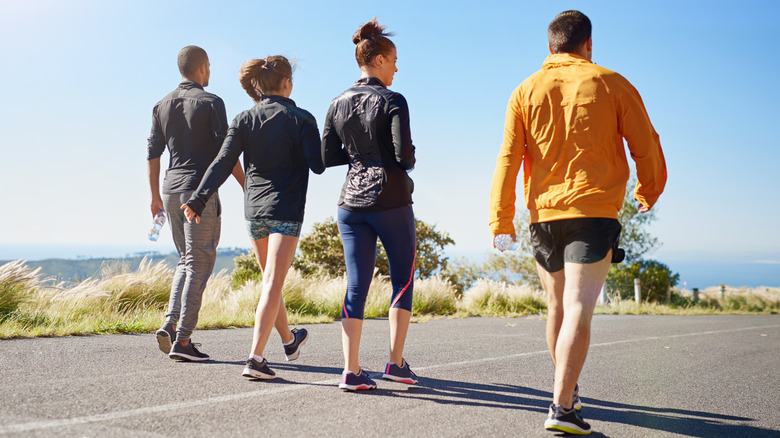What Happens To Your Body When You Try The 'Japanese Walking' Method
It can be tough to hit that recommended 150 minutes of exercise each week. Maybe you love that high-energy spin instructor, but a late meeting can sometimes make you miss class. And let's be honest — some days, motivating yourself to get to the gym can feel nearly impossible, let alone step on a treadmill.
Treadmill or not, walking every day is one of the simplest ways to keep both your body and mind healthy. You don't need a gym membership or a pricey Peloton Tread to step up your walking game. Instead, you can boost your cardiovascular fitness with the Japanese Walking method, which has been shown to improve leg strength, aerobic capacity, and even lower blood pressure. (Read about whether it is better to walk on a treadmill or outside.)
And no, Japanese Walking isn't about slowly wandering through a labyrinth to clear your head. It's actually a form of high-intensity interval training, done while walking. Rather than zoning out at the same pace on the treadmill or sidewalk, you'll be picking up the intensity every few minutes to get real fitness results.
How Japanese walking changes your fitness
Japanese Walking may be trending on TikTok, but it's not actually new. The term comes from Japanese researchers who, about 20 years ago, studied the effects of adding short bursts of high-intensity walking to exercise routines for older adults. In a 2007 study in Mayo Clinic Proceedings, people either walked at a steady, moderate pace for 8,000 steps or performed five sets of 3-minute fast-walking intervals, each followed by 2–3 minutes of easier walking. Both groups walked at least four days a week for five months.
By the end of the study, the high-intensity walkers had strengthened their leg muscles by up to 17% and improved their aerobic fitness by up to 9%. They also lowered their systolic blood pressure by an average of 9 points. In contrast, those who walked at a moderate pace showed little to no improvement, while women in the control group who did no exercise gained a significant amount of weight.
If you're already walking regularly, increasing your intensity may help you see greater benefits. A 2024 study in Cureus compared high-intensity interval walking with moderate-intensity walking, this time using heart rate to guide intensity. Participants in the interval group alternated 3 minutes of fast walking at 85% of their maximum heart rate with 3 minutes of slower walking at 55%. The moderate-intensity group walked steadily at 70% of their maximum heart rate. After walking three times a week for eight weeks, both groups improved their fitness and gained muscle mass.

